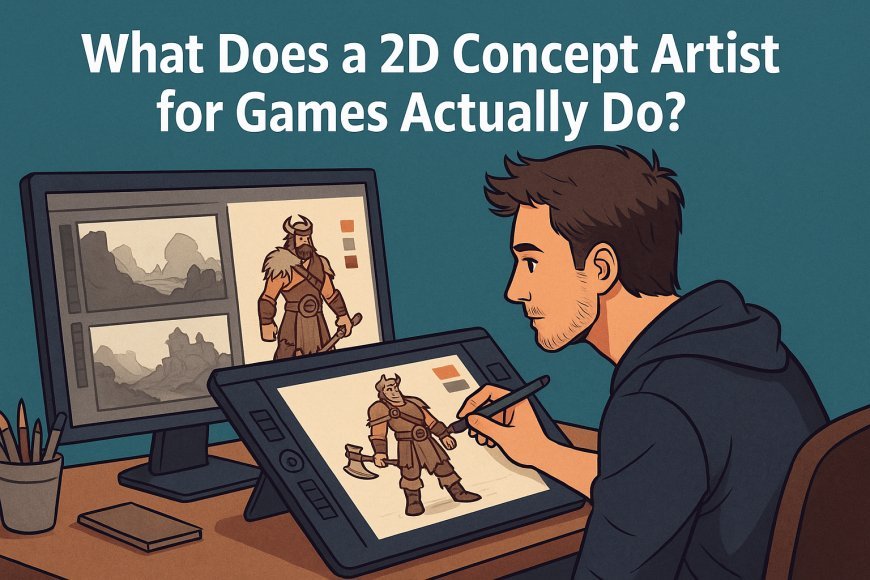What Does a 2D Concept Artist for Games Actually Do?

What Does a 2D Concept Artist for Games Actually Do?
When you dive into a new game and feel instantly immersed , whether it's a lush fantasy world, a gritty post-apocalyptic wasteland, or a futuristic city , you're experiencing the influence of a 2D concept artist These artists are the unseen visionaries who sketch out the first iteration of every character, creature, weapon, or environment you’ll eventually interact with.
But what exactly does a 2D concept artist do in the world of game development? How does their role shape the creative direction of a game? Let’s explore their responsibilities, tools, skills, and career path in detail.
Who Is a 2D Concept Artist for Games?
A 2D concept artist is a professional visual storyteller who translates game ideas into initial designs. They are among the first creatives involved in the development pipeline — often beginning their work before any coding, animation, or modeling has started.
Working closely with art directors, game designers, and writers, they create rough sketches and detailed illustrations to capture the visual identity of the game. Their art sets the tone, style, and direction for everything that follows.
Think of them as architects of imagination. While they don’t build the final structure (that’s the 3D artists and animators), they draw the blueprint that guides everyone else.
Key Responsibilities of a 2D Concept Artist
A 2D concept artist for games wears many hats. Here are some core responsibilities:
1. Character Design
From stoic warriors and quirky sidekicks to alien species or villainous overlords, concept artists create the visual identity of characters. They consider posture, costume, expression, color schemes, and cultural backstories.
2. Environment Design
Whether it's a lush forest, icy tundra, or a ruined space station, the environment tells a story. Artists create mood boards, lighting explorations, and wide-angle environment sketches that establish the game’s visual narrative.
3. Prop and Weapon Design
A concept artist defines how tools, weapons, gadgets, or items look and feel. Even mundane objects like crates or keys need to match the world’s style.
4. Visual Consistency
They ensure that every asset aligns with the game’s theme and tone — whether realistic, stylized, cartoonish, or abstract.
5. Style Exploration
Artists often develop multiple versions of the same asset in different styles to help art directors select the final look.
6. Iteration and Feedback
Concept art is constantly evolving. Artists regularly receive and apply feedback to ensure the visuals support gameplay, story, and technical needs.
Tools Used by 2D Concept Artists
While foundational drawing skills are essential, digital tools have revolutionized the workflow for concept artists. Common tools include:
-
Adobe Photoshop – Industry standard for painting and sketching.
-
Procreate – Popular for on-the-go concepting on tablets.
-
Clip Studio Paint – Especially for comic-style or detailed illustrations.
-
Krita – Open-source software with strong brush engines.
-
Corel Painter – Favored for its traditional painting feel.
-
Blender or ZBrush (optional) – For creating base models or lighting references.
These tools allow artists to iterate quickly, apply color theory effectively, and prepare assets that are clear for production teams.
Essential Skills for a 2D Concept Artist
Becoming a successful 2D concept artist for games requires a combination of technical mastery and creative intuition:
-
Strong Drawing Fundamentals – Anatomy, perspective, composition, and gesture drawing.
-
Design Thinking – Ability to solve visual problems creatively.
-
Understanding of Game Mechanics – Knowing how designs affect gameplay and storytelling.
-
Speed and Adaptability – Fast sketching and adjusting to feedback under tight deadlines.
-
Collaboration – Communicating effectively with writers, developers, 3D artists, and animators.
-
Visual Storytelling – Capturing emotion, personality, and story within a single image.
-
Research Skills – Drawing inspiration from history, fashion, architecture, and other media.
Where Do Concept Artists Fit in Game Development?
2D concept artists typically work at the pre-production stage of game development, but their input is valuable throughout the project. Here's how they interact with other departments:
-
With Game Designers: To visualize gameplay mechanics, level design, or puzzles.
-
With Writers: To align visuals with character backstories and plot arcs.
-
With 3D Artists: To ensure 2D concepts are buildable in 3D space.
-
With Animators: To define movement hints (like how a character’s cloak flows).
-
With UI/UX Teams: To contribute icons, menus, and screen layouts that feel on-brand.
Their art often becomes part of marketing materials, collector’s editions, and art books — showcasing their deep influence on the game's identity.
How to Become a 2D Concept Artist for Games
Wondering how to break into this role? Here's a roadmap:
1. Build Foundational Art Skills
Start with traditional drawing. Master life drawing, still life, perspective, and anatomy.
2. Learn Digital Tools
Get comfortable with Photoshop or Procreate. Explore lighting, textures, and brushwork.
3. Specialize in Game Art
Study game art styles, genres, and pipelines. Know the difference between concept art and illustration.
4. Create a Strong Portfolio
Your portfolio should include character sheets, environment designs, prop breakdowns, and mood boards. Show process — from rough sketch to final render.
5. Get Feedback
Share your work in online forums (ArtStation, Behance, Reddit). Join critique groups.
6. Apply for Internships or Freelance Roles
Start with indie games or game jams. Network with developers on platforms like Itch.io or Unity Connect.
Career Growth & Opportunities
A concept artist’s career can grow in many directions:
-
Junior Concept Artist → Mid-Level → Senior Concept Artist
-
Specializations: Character Artist, Environment Artist, or Creature Designer
-
Advanced roles: Art Director, Creative Director, or Lead Visual Designer
Industries hiring 2D concept artists include:
-
AAA Game Studios (e.g., Ubisoft, EA, Naughty Dog)
-
Indie Game Teams
-
Animation Studios
-
VR/AR Companies
-
Metaverse & Gamification Platforms
Final Thoughts
A 2D concept artist for games is more than just a sketch artist — they’re world-builders, storytellers, and visionaries. Their work sets the creative tone, inspires entire teams, and shapes the experiences of millions of players.
If you love drawing, storytelling, and collaborating on massive creative projects, this role might just be your dream job.
What's Your Reaction?



















































